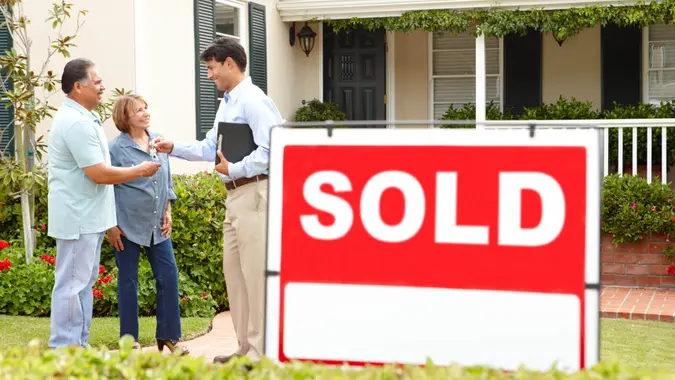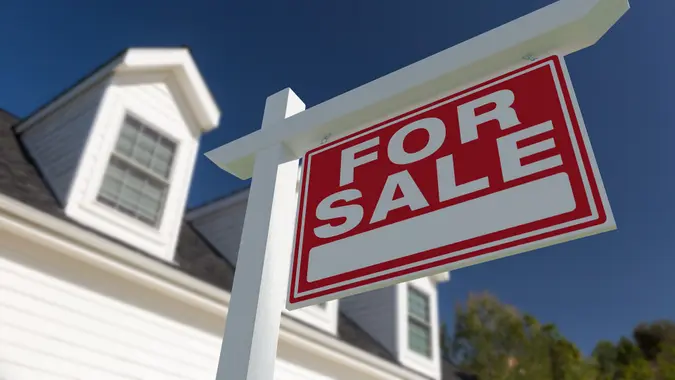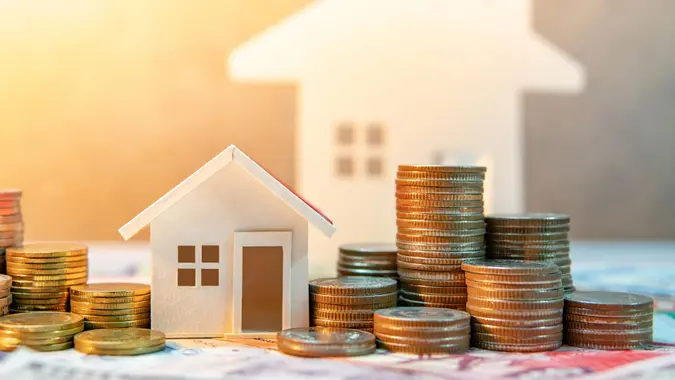How Much Does a 1% Difference Affect Your Mortgage Rate?

Commitment to Our Readers
GOBankingRates' editorial team is committed to bringing you unbiased reviews and information. We use data-driven methodologies to evaluate financial products and services - our reviews and ratings are not influenced by advertisers. You can read more about our editorial guidelines and our products and services review methodology.

20 Years
Helping You Live Richer

Reviewed
by Experts

Trusted by
Millions of Readers
One percent more on your mortgage rate might not sound like a lot, but with loan terms that extend for decades, a single percentage point can cost homebuyers tens of thousands of dollars.
Not only can slightly higher interest rates cost big bucks over time, but with lenders today charging 7% or more, buyers are seeing their purchasing power reduced, their choices limited and their ability to build equity hampered.
What Is a 1% Difference? About $100 per Month and $38,000 Over 30 Years
In terms of money paid to the bank that could have been in your savings account, a single percentage point is much more significant than it sounds.
“When a homebuyer secures a mortgage with a 1% lower interest rate, the impact over time can be substantial,” said Seth Jacobs, a mortgage expert and founder of Maine USDA Home Loan. “Lower interest rates translate to reduced monthly mortgage payments, which means homeowners can save a considerable amount of money over the life of the loan.”
Here’s the math if you make a 20% down payment of $40,000 on a $200,000 home and mortgage the remaining $160,000:
- With a 6% interest rate, you’ll pay $959 per month for a total of $185,522 over 30 years.
- With a 7% interest rate, you’ll pay $1,064 per month for a total of $223,630 over 30 years.
That seemingly insignificant percentage point costs you $105 per month or $1,260 per year. Over the life of the loan, the difference between 6% and 7% comes out to $38,108 paid in interest that could have been in your college fund or nest egg. And keep in mind, those figures don’t include property taxes and insurance.
A Single Percentage Point Means a Lot Less Purchasing Power
A 1% hike in your mortgage rate doesn’t only increase your monthly payment, it also reduces the amount of house you can buy.
Mortgage lenders issue loans based on the monthly payment you can afford according to your debt-to-income ratio, including interest payments on the money you plan to borrow. According to Find My Way Home, you lose about 5% of your purchasing power with every half a percentage point in interest the bank charges.
If your lender determines you can afford $1,000 per month, it will loan you $166,792 at 6% interest. But if the interest rate rises to 7%, you’ll have to shop for something that costs no more than $150,308.
Interest: The Great Equity Killer
Paying down your principal is the most direct way to build equity in your home, but equity-building slows down with every percentage point your interest rate ticks up. That’s because when rates are low, a bigger chunk of each payment goes toward the principal amount.
“In the long run, this can lead to substantial savings and an accelerated path toward owning the property outright,” said Jacobs. “Conversely, if a homeowner ends up with a mortgage featuring 1% higher interest, the effects can be financially burdensome. Higher monthly payments and a greater proportion of each payment going towards interest can stretch budgets and make it challenging to build equity at a desirable rate.”
Buy Now With Plans To Refi or Wait Out the Storm?
Today, many buyers are biting the bullet and settling for high-interest mortgages with plans to refinance when rates fall again a few years down the line.
The problem with this strategy is that interest is front-loaded on mortgage loans, meaning that your early payments in the first few years go mostly to interest so the bank gets its money’s worth even if you sell or refinance soon after buying. The higher the rate, the more lopsided in favor of the bank the amortization schedule becomes. When you refinance in a few years, you’ll have paid thousands to your original lender while barely nibbling away at the principal amount you borrowed — and refinancing isn’t free.
“The savings from a 1% lower interest rate may not be substantial enough to outweigh the costs associated with refinancing or securing the initial loan,” said Jacobs, who stressed that the strategy makes sense mostly for buyers who intend on remaining in the home for a long time.
Other prospective buyers are simply putting their dream of homeownership on hold until money becomes cheaper to borrow. That, too, comes with risks.
“While attempting to time the market might seem appealing, it can be a daunting task,” said Jacobs. “Mortgage rates are influenced by a variety of economic factors, and predicting their movements accurately is challenging. Opting to wait for rates to drop may lead to missed opportunities and possible frustration if rates rise instead. It’s essential to collaborate closely with a trusted mortgage professional who can help navigate these fluctuations and recommend the best course of action based on individual financial goals and market conditions.”
 Written by
Written by  Edited by
Edited by 
























